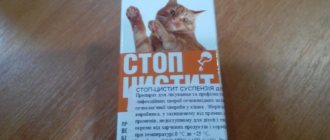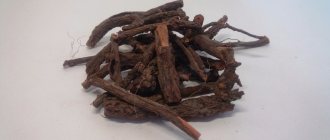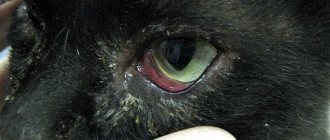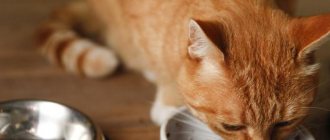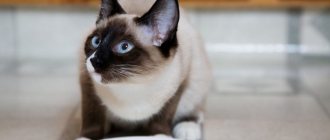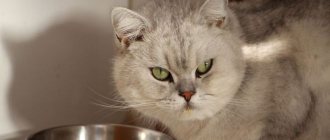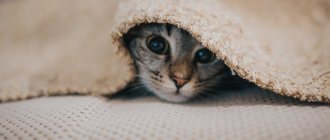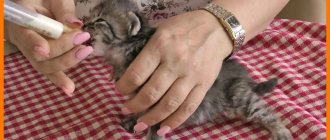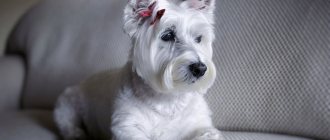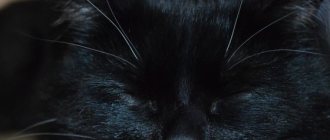Urolithiasis (urolithiasis) occurs in every fourth cat. This is a serious health threat that reduces your pet's quality of life.
Nutrition is one of the causes of ICD. At the same time, a proper diet is a way to change the well-being of an animal suffering from this pathology for the better. There are special foods for cats with urolithiasis. Their main task is to dissolve stones in the bladder and prevent the formation of new ones. And in some cases, veterinary foods can replace medications.
The danger of urinary stones
Cat urine contains soluble and insoluble salts. If the animal is healthy, the substances are excreted in urine. When metabolic processes in the body are disrupted, the amount of insoluble elements increases, which gradually turn into sand. And stones (uroliths) are formed from sand. They can be very small or reach the size of a walnut. The cat experiences discomfort when the stones begin to injure the mucous membrane of the bladder and urethra (urethra).
The most serious threat is blockage of the urethra with a stone. The condition is possible only in cats and threatens the animal with death from intoxication and rupture of the bladder.
"Home kitchen"
In general, quite a lot of feed similar to those described above are produced today. They are great for daily feeding of sick pets... but their cost and low availability (they are not available in all pet stores) scares off many breeders. What if for some reason you cannot purchase commercial varieties of food suitable for cats with ICD? You'll have to make do on your own.
First, a little theoretical biochemistry. The owner’s main task is to increase the volume of daily urine production, but at the same time reduce its concentration . Even if there are factors in the animal’s body that contribute to the deposition of crystals, under such conditions the process will proceed disproportionately slower. Secondly, it is imperative to achieve alkalinization of urine .
The most difficult task is to limit the daily intake of protein, despite the fact that the cat’s body still needs it. N-(2-mercaptopropionyl)-glycine , as well as penicillamine . The first reduces the absorption of certain protein compounds, the second significantly reduces the amount of microelements assimilated. Yes, this is harmful, but when these substances are added to food, there is simply nowhere in the urine for compounds that could precipitate, forming uroliths. Alas, there are two unpleasant circumstances at once.
Firstly, long-term use of these drugs is fraught with severe vitamin deficiency and exhaustion . Secondly, about 40% of animals generally react to their intake with severe vomiting. To prevent vitamin deficiency, replacement therapy must be carried out. For this purpose, the animal is prescribed Gamavit or a similar medicine.
Some veterinarians believe that the problem of vomiting can be solved by giving medications mixed with some fat. Such a diet for urolithiasis in cats, among other things, can stimulate the development of appetite in a sick pet.
Nutrition: enemy and ally
Malnutrition in cats is one of the provoking factors for the development of urolithiasis. Therefore, when choosing food, you need to consider the following nuances:
- A number of feeds contain excess amounts of phosphorus, magnesium, and calcium. These elements contribute to the formation of crystals in urine.
- The food has a significant effect on the acidity of urine (pH). The cat’s body is “tuned” to digest animal food, which makes the urine slightly acidic, and therefore prevents the formation of stones. In such an environment, crystals dissolve. If the diet is dominated by products of plant origin, which is often found in cheap brands, the pH of the urine shifts towards slightly alkaline. And this contributes to the formation of struvite - one of the most common types of stones.
The likelihood of developing the disease increases if the cat drinks little. In this case, the urine becomes too concentrated and stones form faster.
Causes of ICD
There are many factors that contribute to the development of urolithiasis. All reasons are conventionally divided into external and internal. In this case, a combination of several provoking conditions is possible.
Exogenous
External causes are related to the living conditions, activity, and nutrition of the cat. One of the first places is irrational nutrition. An imbalance of proteins, fats, and carbohydrates leads to a shift in urine pH to the acidic or alkaline side. In both cases, solid conglomerates begin to form in the urinary organs. Vitamin deficiencies are also related to diet. All biologically active substances are important, but this is most true for vitamins A and D. Vitamin deficiency leads to metabolic disorders.
Thirdly, the lack of water and/or the high saturation of the liquid with minerals affects it. This factor affects the concentration of urine. In a more saturated liquid, solid inclusions form faster. The need for water increases if the cat lives in hot home conditions.
For some scrupulous cats, the cleanliness of the tray is important. Dirty litter makes the animal endure. Retention of urination provokes and accelerates stone-forming processes in the urine. In this case, signs of the disease appear faster.
Urolithiasis in cats is most often recorded at the very beginning of autumn, as well as in January-April.
Endogenous
Hormonal disorders can lead to the development of urolithiasis in cats. Internal causes also include diseases of the digestive system. If the food contains enough nutritional and biologically active compounds, but the cat has intestinal problems, the valuable substances will be poorly absorbed by the body. It is endogenous reasons that explain why cats of one breed or another are prone to urolithiasis. A set of genes, changes in their activity or structure influence the occurrence and rate of progression of urolithiasis in cats.
Features of nutrition with ICD
The physiology of cats has a peculiarity - animals rarely experience thirst, and their urine is highly concentrated. The goal of medicinal food for urolithiasis is to make pets drink a lot and go to the toilet more often. To make the cat thirsty, salt (sodium) is added to the composition. With frequent urination, the crystals are washed out and stones do not have time to form.
Moreover, if there is too much salt, the kidneys begin to secrete more calcium, which promotes the formation of oxalates. Therefore, it is up to the veterinarian to decide what to feed the cat.
What you should know when choosing food
Medicinal feeds are presented only in products ranging from premium class and above. On each package there is a mark that the food is intended for animals with urolithiasis and what type of stones it is suitable for. The type of stones is determined in a veterinary clinic based on laboratory tests. An additional bonus will be the presence of vitamin supplements (vitamins A and group B).
Important! Medicinal food for cats with urolithiasis should not contain a high content of vitamin C, since it promotes stone formation.
Always consult your veterinarian before starting or continuing the use of any medicated food. He or she can determine appropriate serving sizes for your pet or recommend sticking to the dosages indicated on the package.
Diet of castrates with urolithiasis
There is an opinion that castration slows down the metabolism in the body. Therefore, neutered cats are at risk of developing urolithiasis. This version is considered incorrect. In fact, stones in castrati occur primarily due to the fact that they begin to lead a sedentary lifestyle, which slows down their metabolism.
In this category of animals, veterinary diets are used not only for the treatment, but also for the prevention of urolithiasis. The digestion of a castrated cat and a regular cat is no different, so all the above-described foods are suitable.
Top 8 foods for the prevention of urolithiasis in cats
| Place | Struvite type of stones | Oxalate type of stones |
| 1 | Farmina Vet Life Cat Struvite Management | Monge VetSolution Urinary Oxalate |
| 2 | Hill's C/D Multicare | Hill's Prescription Diet K/D |
| 3 | Royal Canin Urinary S/O | Purina Pro Plan Veterinary Diets UR |
| 4 | Forza10 Urinary Active | |
| 5 | 1st Choice Adult 1+ Year Urinary Health |
Preventive diet
The greatest importance for preventing the development of urolithiasis is what to feed the cat after urolithiasis.
For everyday nutrition and at the same time prevention, you need sufficiently high-calorie food, consisting mainly of animal ingredients - meat and fish.
Animal protein contains amino acids that maintain an optimal level of urine acidity (6-6.5 pH). Cereals are high in sodium and alkaline your urine. Therefore, a diet with a large proportion of grains is not suitable for cats either for the treatment or prevention of struvite-type urolithiasis. Only corn gluten also acidifies urine, so its presence in the composition is acceptable. However, most industrial feeds contain a significant percentage of cereals. This means that you need a careful approach to choosing a specific brand.
An important measure to prevent urolithiasis is drinking regime. The cat must consume sufficient fluids. It is better not to give tap water to animals, but to use filtered or bottled water. Water must be constantly available. Animals do not like stagnant water, so it needs to be changed as often as possible.
Hill's brand food is suitable for prevention:
- Prescription Diet Feline C/D. The product minimizes the risk of struvite formation. Suitable for long-term use. The food is available in two varieties - based on chicken and sea fish. Calorie content 388 kcal/100 g. Contains minimal amounts of magnesium and phosphorus.
- With the oxalate type, the level of phosphorus and magnesium is not reduced. Should be less sodium and protein. Therefore, food lines S and C are not suitable. To prevent oxalates and other types of uroliths, such as cystines, you need the Hills K/D diet.
Feeding pets with kidney disease natural food
Natural food is suitable for animals of those owners who want to personally monitor the quality of the products their cats receive. Organizing a diet based on regular food is quite difficult: you need to consult with a veterinarian and calculate by gram the amount of proteins, fats and carbohydrates required for your furry baby.
Vitamins and mineral complexes should also be selected based on data on the cat’s age, the nature of the disease and the composition of the stones. In some cases, it may be necessary to add prebiotics and probiotics to your food to improve gastrointestinal function.
Don't forget to also monitor the quality of the water: tap water is not suitable for cats with urolithiasis. It is recommended to install special filters or boil the kettle regularly. You can also use clean, still bottled water: refresh it every day so that it does not stagnate in the bowl or become clogged with dust. Cat food should be prepared without salt and spices, without adding flavor enhancers. It is necessary to serve food moderately warm so that the animal does not get burned or catch a cold.
What foods are strictly prohibited from being given to cats with any kidney pathologies:
- Sausage and frankfurters. They contain various flavoring additives and a lot of salt, which negatively affects the condition of the pet’s excretory system.
- Any bones. Bones are rich in phosphorus and calcium, which in excess amounts can provoke an exacerbation of urolithiasis. You should also take into account the fact that the cat can be injured by the uneven edges of the bone.
- Cream and full fat milk. In older animals, the breakdown of milk proteins is much worse, which can result in indigestion and stool failure.
- Various salty seafood snacks and any fish. These foods are also rich in salts, which, when accumulated in a cat's body, can cause stones to form.
- Mushrooms and legumes (chickpeas, lentils, peas). The use of such products in an animal’s diet has an undesirable effect not only on the kidneys, but also on the gastrointestinal tract, since they are quite difficult to digest.
Photo gallery: food unhealthy for pets
Seafood contains a lot of salt
Peas are a difficult food for a cat's body.
Sausages contain many foreign additives.
What can be added to the diet of an animal with kidney disease:
- Meat. Beef, pork and offal should be added to dishes in small quantities. Turkey or chicken fillets should also be included in your cat's daily diet. Meat and poultry should be given raw or boiled, removing fat and bones.
- Dairy products. As a treat, you can introduce sour cream, kefir or fermented baked milk, and cottage cheese into the animal’s diet. Sweet yoghurts with additives and ice cream are prohibited foods.
- Cereals and porridges. Buckwheat, oatmeal, rice, millet and corn are beneficial for a cat’s body. It is recommended to mix the porridge with pieces of meat and add a little butter.
- Boiled eggs and fish oil can be sources of fat. They help meet the need for essential fatty acids and do not harm the body.
- Vegetables are the best source of vitamins. It is recommended to add finely chopped boiled and fresh vegetables (zucchini, pumpkin, carrots, broccoli) to cat dishes.
Photo gallery: healthy food
Boiled chicken - contains a lot of animal protein
Kefir is the best source of lactic acid bacteria
The egg contains the optimal amount of proteins and fats
My cat, who is a Persian mix, was diagnosed with urolithiasis when he was nine years old. Most of the animal's diet consisted of sea and freshwater fish, as well as dry food. After confirming the diagnosis, I had to completely review my pet’s diet and give up some foods to protect him from the recurrence of the disease. Now he eats mostly lean meats, grains and some vegetables, and also regularly takes vitamin and mineral supplements and drinks a lot of clean water. Thanks to proper nutrition, it was possible to completely normalize urine analysis and get rid of unwanted manifestations of the disease.
Diet
When creating a menu, it is not recommended to completely exclude natural products. They are a source of vitamins and help normalize the digestive system.
Lean meats
Cat diseases: symptoms, table, treatment
Turkey, rabbit and chicken can be given to your cat raw, provided there are no bones or fat in the meat (it is recommended to give preference to fillet). Beef and pork are included in the animal’s diet only when well boiled. The broth left over after cooking meat can be given to the cat in its pure form or used for making soups.
Important! Meat for feeding a furry patient should be fresh and lean. No salt or spices are added to it during the cooking process.
Vegetables with minimal alkali content
It is recommended to give your cat fresh pumpkin and zucchini in small quantities; British and Siberian cats also include fresh cucumbers in their diet. It is beneficial for animals to prepare soups based on carrots or cabbage.
Prevention of oxalate type urolithiasis:
- Of course, it is necessary to monitor your pet's water consumption. According to various sources, the average amount of water drunk should be 20-40 ml per kilogram of a cat’s weight per day. The numbers may vary depending on what type of food she receives (dry, wet, human food variety), how active the pet is during the day, and so on. If you have placed bowls, wine glasses, fountains around the apartment, periodically open the drain in the sink, change the water to fresh every day, try different drinking water manufacturers, but the cat still does not drink, you can try to improve the quality of the places where the dishes are. Hang toys near bowls, and place mugs near your pet's favorite places (such as the couch) so that the cat will be more interested in these places. Cats are creatures with a subtle mental organization; they have a lot of fears and mistrust of the world around them. To prevent a cat’s fearful behavior, you can use special diffusers and sprays with analogues of the pheromones of the facial glands of cats (when cats rub their faces against something, they release these pheromones, thereby marking what can be trusted - this can be a person or a chest of drawers, And so on). These devices will help the cat relax, which can additionally lead to good water intake.
- Use high quality food that provides a balanced diet for your pet. Such nutrition may seem expensive, but believe me, it is cheaper than the diagnosis and treatment of many diseases.
- Bring your cat for medical examination in a timely manner so as not to miss an incipient or progressing disease. Clinical examination usually includes standard blood and urine tests, ultrasound of the abdominal organs (blood tests and ultrasound are done on an empty stomach after 8-10 hours of fasting, but water should be left freely available), and if necessary, additional studies.
- If you notice any of the signs or a combination of them - frequent urge to urinate, blood in the urine, vocalization (the animal screams on the tray or simply calls you to pay close attention to it), urine in small quantities - you should contact a specialist as soon as possible.
- Prevention of stress - try to change the animal’s environment to a minimum (repairs, moving), give your cat as much of the required attention as possible, provide everything necessary for a comfortable environment (scratching posts, toys, beds), it is possible to use anti-stress medications (as prescribed by a doctor).
In our clinic you can receive the full range of services described. You can make an appointment through our call center 8(495)995-50-30, as well as through the feedback form on the website vetacademy.ru.
Take care of your four-legged friends!
Return to list
